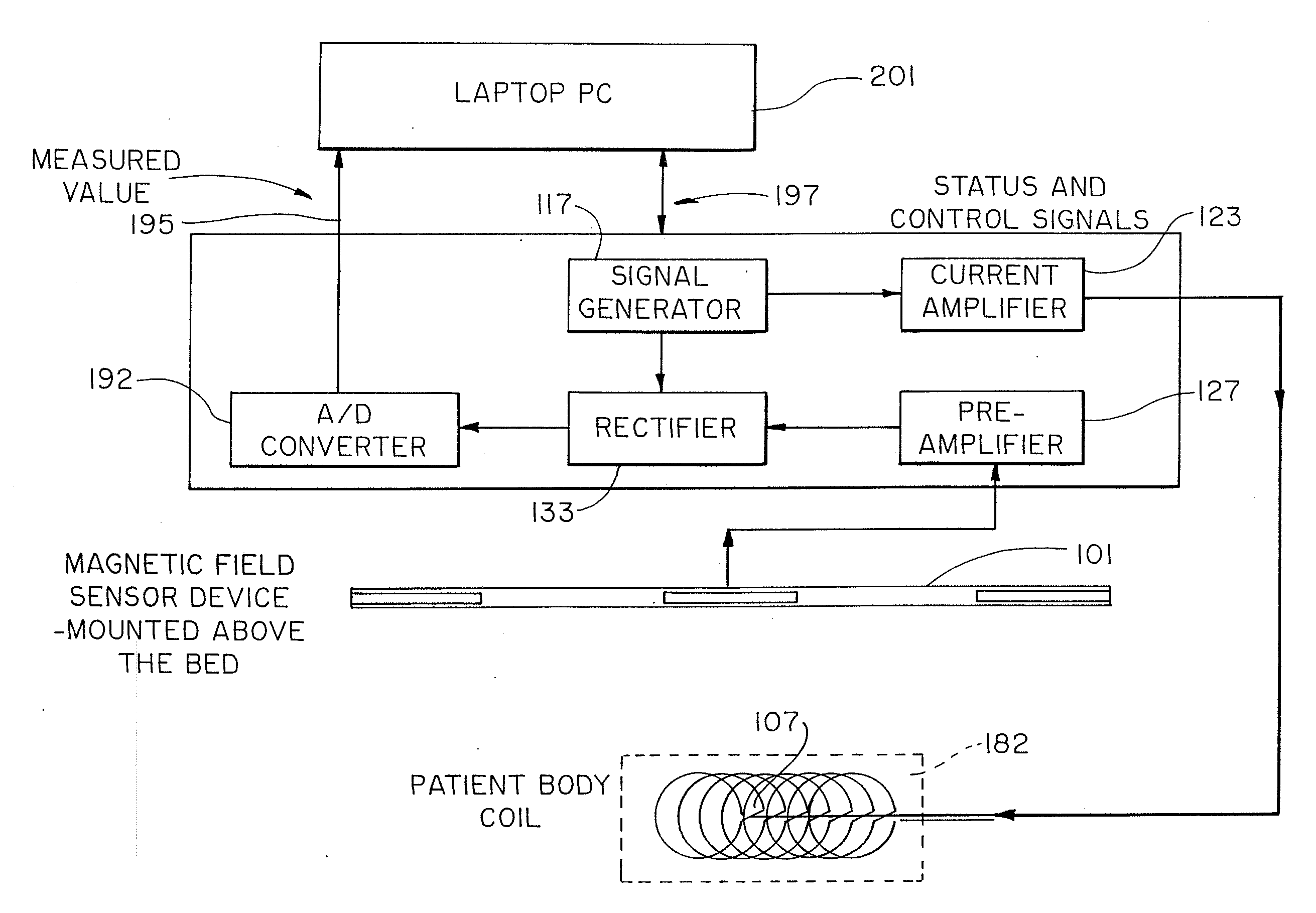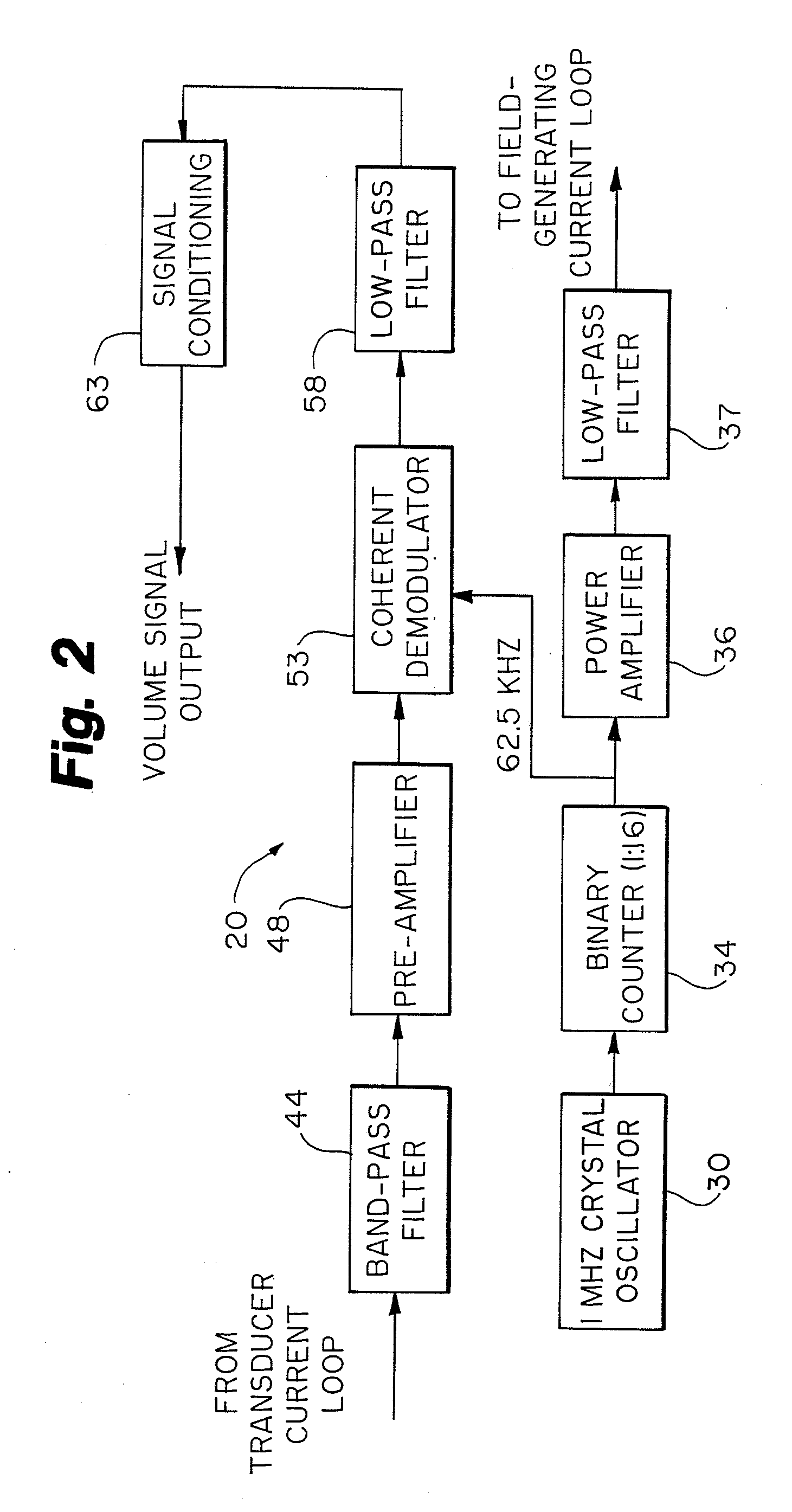Volumetric physiological measuring system and method
a physiological measurement and volumetric technology, applied in the direction of respiratory organ evaluation, electrical/magnetic measuring arrangement, compasses, etc., can solve the problems of inability to obtain reliable data, crude and inaccurate measurements, and inability to use airway-based techniques to achieve reliable data, reduce circuit cooling and power supply capacity, and minimize the total power consumption of amplifier units
- Summary
- Abstract
- Description
- Claims
- Application Information
AI Technical Summary
Benefits of technology
Problems solved by technology
Method used
Image
Examples
example 1
[0058]A circular electrical conductor loop with a radius of 1.5 meters was placed on the floor. An alternating current of 0.1 A with a frequency of 100 kHz was fed through the conductor from a signal generator. A small, 10×10 cm (100 cm2) square conductor loop was connected to the input of a broadband signal amplifier with a gain of 40 dB, and the output from this amplifier was passed through a narrow 100 kHz band-pass filter with no gain. The output signal from the filter was presented on an oscilloscope screen, where voltages could be read by cursors. When the small loop was positioned flat on the floor in the center of the larger current loop, a voltage of 5 mV p / p was measured. This voltage remained essentially constant when the small loop was elevated 50 cm above the floor, and it also remained constant when the small loop was moved up to 50 cm in any horizontal direction away from the center of the large current loop. Another square loop, measuring 14.1×14.1 cm, with an area o...
example 2
[0059]The same conductor loops as described in Example 1 were used, but the 0.1 A current from the signal generator was fed to the 100 cm2 loop, and the large loop on the floor was connected to the input of the 40 dB broadband amplifier. The small loop was positioned as explained in Example 1. The same general relations between induced voltage and loop position and area was observed as in Example 1, however the voltages were reduced to 250 μV when using the 100 cm loop, and 500 μV when using the 200 cm2 loop.
example 3
[0060]Referring to FIG. 11, three identical cylindrical ferrite rods 175 with a diameter of 8 mm, length of 150 mm and permeability of 100 were arranged along a straight horizontal line with a common axis. The end-to-end horizontal spacing between each rod was 50 cm. The two outer coils were equipped with 163 turns of lacquer-insulated 0.1 mm copper wire evenly distributed along a central 8 cm segment of the rod, while the center rod had 100 turns arranged in the same manner. The coils were electrically connected in series, and care was taken to assure identical current directions in all coils. The serially connected coils were then tuned to parallel resonance at 100 kHz with a common capacitor 177 of about 10 nF. An oscilloscope directly monitored the signal from the resonant circuit. A 10 cm×10 cm current loop carrying a 100 kHz alternating current of 0.1 A was positioned adjacent to the coil assembly, keeping the orientation of the loop perpendicular to the ferrite rods common ax...
PUM
 Login to View More
Login to View More Abstract
Description
Claims
Application Information
 Login to View More
Login to View More - R&D
- Intellectual Property
- Life Sciences
- Materials
- Tech Scout
- Unparalleled Data Quality
- Higher Quality Content
- 60% Fewer Hallucinations
Browse by: Latest US Patents, China's latest patents, Technical Efficacy Thesaurus, Application Domain, Technology Topic, Popular Technical Reports.
© 2025 PatSnap. All rights reserved.Legal|Privacy policy|Modern Slavery Act Transparency Statement|Sitemap|About US| Contact US: help@patsnap.com



